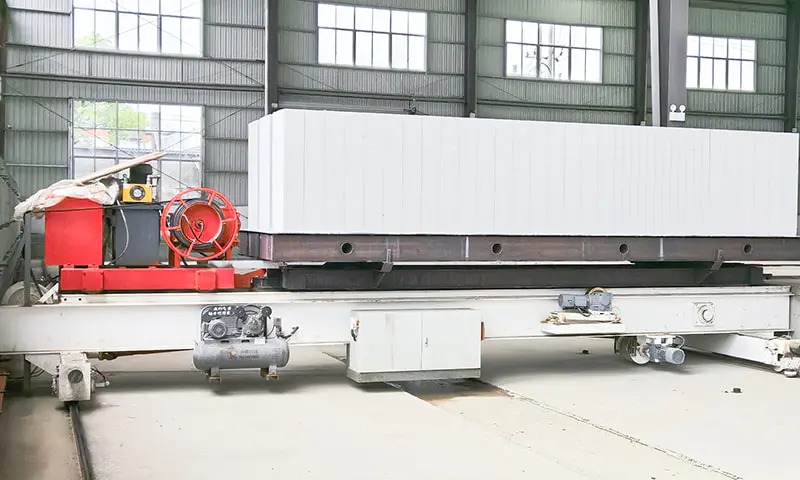In the wave of intelligent transformation of industrial manufacturing, the technological innovation of Ferry Car After Autoclave is bringing revolutionary changes to the production line. The latest modularly designed autoclave rear transfer truck successfully breaks through the load limit of traditional equipment and achieves a flexible configuration range of 10-50 tons through an adjustable structure. This breakthrough progress significantly improves the adaptability and economics of the logistics system behind the autoclave. Test data shows that this design can increase the efficiency of handling products of different specifications by more than 35% without replacing core equipment on the same production line.
The modularly designed Ferry Car After Autoclave is mainly composed of three core modules: an expandable frame structure, an intelligent counterweight system and a variable frequency drive unit. The frame adopts a high-strength alloy steel splicing design, and the load area can be quickly adjusted by increasing or decreasing the number of beam body modules; the intelligent counterweight system can automatically identify the weight of the vehicle and optimize the center of gravity distribution to ensure operational stability under a load of 5-50 tons; and the modular variable frequency drive unit achieves power matching on demand, reducing energy consumption by 20% while ensuring power output. This design concept perfectly solves the industry pain points such as the risk of "big horse pulling small cars" or overloading of traditional transshipment vehicles.
From the perspective of technical parameters, the modular Ferry Car After Autoclave has achieved several performance breakthroughs while maintaining basic functions. Its track adaptive system is compatible with different gauge requirements of 800-2000mm, and the turning radius can reach 6 meters at a minimum; the high-temperature resistant module adopts special ceramic coating, and the continuous working temperature reaches 400℃; the positioning accuracy is controlled within ±3mm, fully meeting the docking needs of automated production lines. What is more worth noting is that all functional modules adopt a quick disassembly design, and the regular configuration changes can be completed within 2 hours, greatly shortening the downtime of production line adjustments.
In the field of building materials manufacturing, modular Ferry Car After Autoclave shows unique advantages. Concrete prefabricated parts manufacturers can flexibly adjust the transfer truck configuration according to the specifications of pipe piles (from Φ300mm to Φ1500mm); the aerated block production line can match different load-load versions according to the change in the autoclave capacity. This adaptability not only reduces the cost of equipment procurement, but also optimizes the space utilization rate of the factory. Industry estimates show that after adopting modular design, the overall return on investment of the logistics system in the back section of the autoclave can be increased by 40%.
With the strengthening of product customization trend, modular Ferry Car After Autoclave is reshaping the operation model of the autoclave post-processing process. Traditional fixed transfer vehicles are often unable to handle multiple varieties and small batch orders, and modular solutions perfectly solve this problem through rapid adjustment. Production data shows that when dealing with products with large differences on the same production line, the replacement efficiency of the modular system is 6-8 times higher than that of traditional equipment, which is of decisive significance to modern manufacturing companies produced on orders.
From the perspective of industry development, modular design represents an important evolutionary direction of Ferry Car After Autoclave technology. This design not only solves the current flexibility needs of the manufacturing industry, but also reserves space for future technological upgrades. Through standardized interfaces, new sensors, energy efficiency optimization modules or intelligent scheduling systems can be easily installed. It is expected that in the next five years, autoclave post-transfer trucks using modular architecture will occupy more than 60% of the market share, becoming an indispensable intelligent logistics unit for the autoclave production line in the Industrial 4.0 era.







